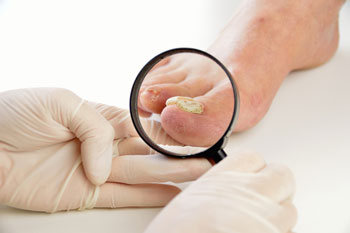






Nail fungus is a very prominent condition affecting the feet. Research has found up to 18% of the worldwide population to have experienced toenail fungus. Other studies have revealed that 25% of all adults will experience some type of nail fungus by the time they are 40 years old. Toenail fungus is characterized by thickening of one’s toenails along with discoloration. Typically, this infection begins as a small white or yellowish discoloration of the nail and spreads with time. Other times, it accompanies an Athlete's foot condition.
There is a saying "fungus is among us." Fungus may be picked up walking barefoot outside or contracted by walking barefoot around swimming pools, gym floors, or at public showers. People with sweaty feet or those who wear heavy socks causing the feet to sweat are more likely to develop fungus. Fungus likes to live in dark and damp environments and shoes provide an optimal place for it to breed.
It is known that trauma to one's toenail is a major cause of fungus infections, which are rampant in athletes that have microtrauma to their nails such as ballet dancers who go up on pointe and runners or soccer players whose nails are constantly rubbing inside the shoes.
There are several over-the-counter medications for fungus of the feet; however, they are not FDA approved for treatment of toenail fungus. Some of this may be due to the cost involved in getting FDA clearance for an actual fungus toenail medication. Topical prescription anti- fungal medications are available, and they are intended for distal toenail fungus only. In other words, their studies, which were submitted for FDA clearance, utilized patients with a noninfected clear area at the base of the toenail. So, if you have a spike of fungus or abnormal appearance of nail at the base of the toenail, none of the topical prescription medications are currently FDA indicated. This is not to say that they will not help the toenail.
When one presents to our office for treatment of fungus nails, the nails are evaluated and a nail biopsy is performed to determine what type of fungus is present. There are multitudes of different types of fungus and yeast and even bacteria which can invade the toenail. As the fungus spreads, it kills the skin under the toenail. The more dead skin, the more it raises and deforms the toenail. We will; therefore, painlessly trim the toenail back, getting rid of the unsightly and thickened nail as well as dead skin debris under the toenail plate. We recommend and offer a nail conditioner to help soften the nail which makes them easier to cut and also helps prevent spread of the fungus. In addition, we often prescribe oral medications to help kill the fungus and improve the nail condition as the nail grows outward. Several fungal nail studies have been done with improvement gained at three to nine months after taking oral medications with an approximate 70% success rate. We monitor and treat ones’ toenails during this period to get the best possible results. Laser nail treatments are avoided at our office as they are costly and provide temporary results.
Should you or someone in your family desire care of fungal nails, please do not hesitate to contact to our office for expert care.
Written by Richard T. Braver, DPM, FACFAS






